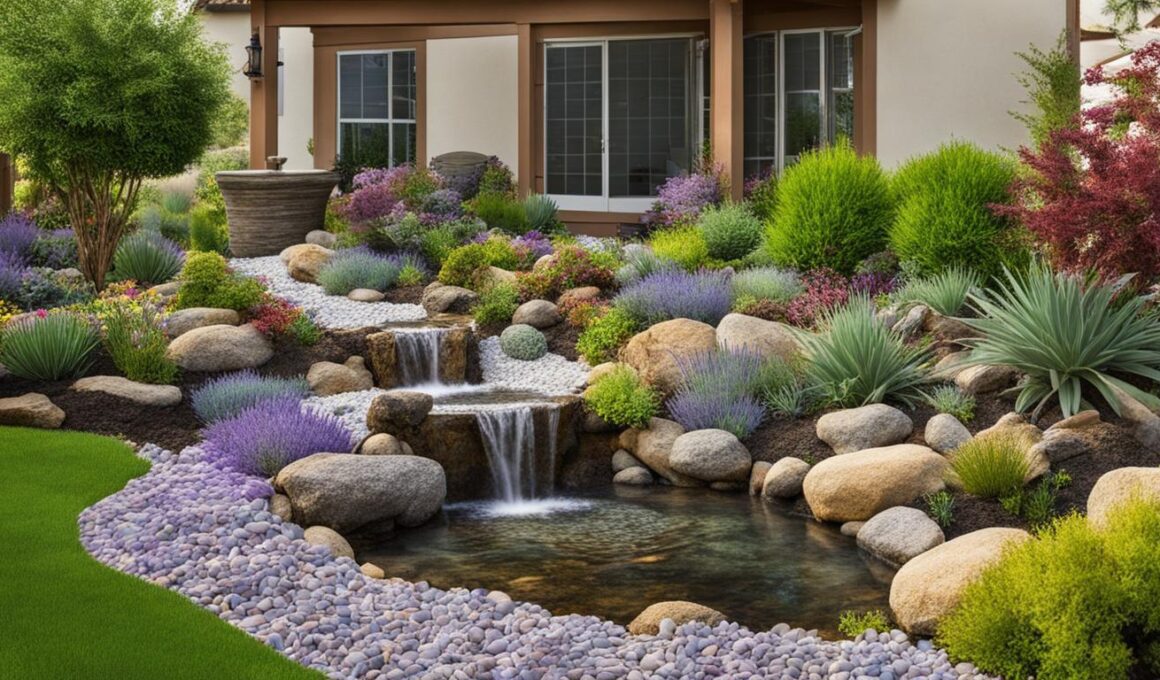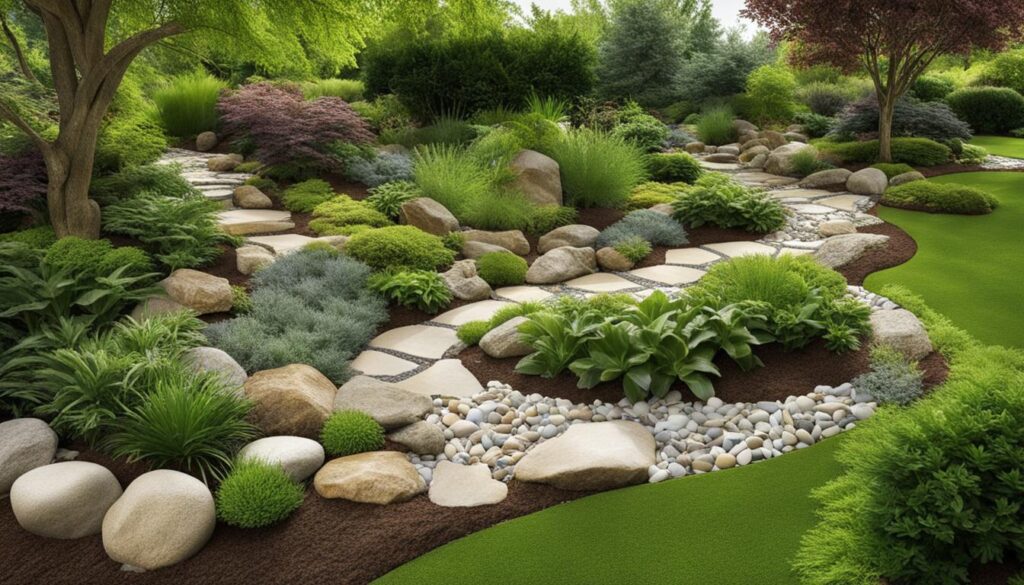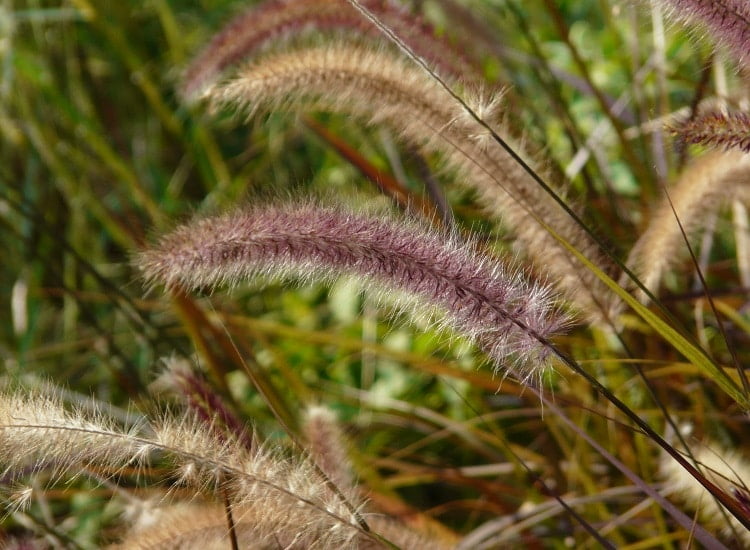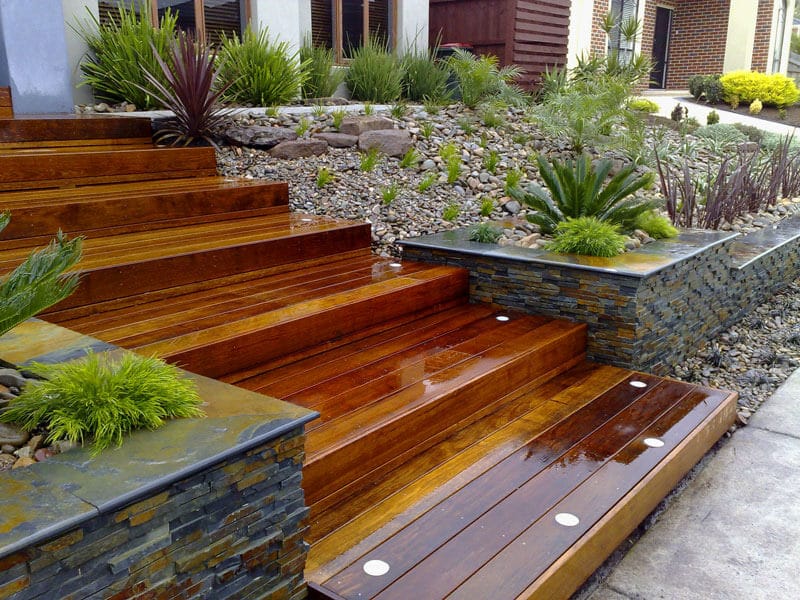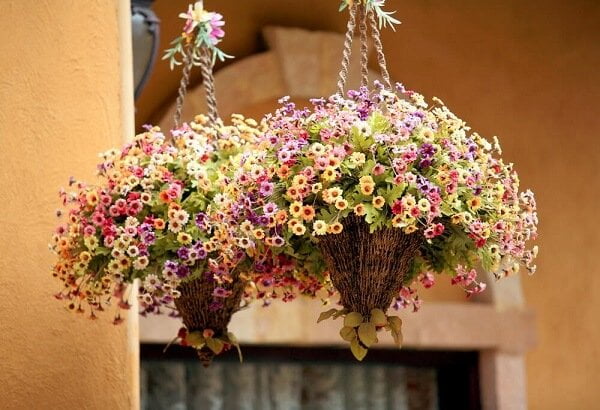A rock garden is a beautiful and low-maintenance landscaping option that can transform your yard into a tranquil oasis. Building a rock garden is a rewarding project that requires careful planning and design. With the right materials, plants, and techniques, you can create a stunning stone-filled space that will add visual appeal and serenity to your landscape.
Key Takeaways:
- Building a rock garden is a rewarding and low-maintenance landscaping project.
- Careful planning and design are crucial for creating a stunning rock garden.
- Having the right materials, plants, and techniques is essential for a successful rock garden.
- Rock gardens come in various types, such as xeriscapes, Japanese rock gardens, water gardens, and native plant gardens.
- Consider the design, shape, size, and color scheme when planning your rock garden.
Types of Rock Gardens
Rock gardens come in a variety of types and designs, each offering unique characteristics and benefits. Here are some popular types of rock gardens:
Xeriscapes
If you’re looking for a low-maintenance and eco-friendly option, xeriscapes are perfect for you. These rock gardens feature drought-tolerant plants, such as succulents and cacti, that require minimal watering. By minimizing water usage, xeriscapes conserve resources while still adding beauty and texture to your landscape.
Japanese Rock Gardens
Also known as Zen gardens, Japanese rock gardens are designed to create a sense of tranquility and meditation. These gardens often feature carefully arranged rocks and gravel, symbolizing mountains and water bodies. The simplicity and balance of Japanese rock gardens inspire contemplation and reflection.
Water Gardens
Water gardens combine the beauty of rocks with the serenity of water features. These gardens often include elements like koi ponds, waterfalls, and fountains, creating a peaceful and soothing atmosphere. Water gardens can be a focal point in your landscape, attracting wildlife and providing a habitat for aquatic plants.
Native Plant Gardens
If you want to create a rock garden that supports local biodiversity, consider a native plant garden. These gardens feature plants that are indigenous to your region, attracting native birds, butterflies, and other beneficial wildlife. By using native plants, you can promote ecological balance and preserve the natural beauty of your area.
Whether you choose xeriscapes, Japanese rock gardens, water gardens, or native plant gardens, each type offers a unique way to enhance your landscape with the timeless beauty of rocks and plants.
Essential Elements and Materials
When building a rock garden, it’s important to gather the essential elements and materials that will bring your vision to life. By selecting the right rocks, soil, plants, and tools, you can create a stunning and functional rock garden that will be the envy of your neighbors. Let’s explore the key components you’ll need to make your rock garden a success.
Rocks of Varying Sizes and Shapes
The foundation of any rock garden is, of course, the rocks themselves. Choose rocks of varying sizes and shapes, such as boulders, stones, and gravel, to create visual interest and texture. Large boulders can serve as focal points, while smaller rocks can be used to line pathways or create borders. Arrange the rocks in a way that mimics nature and creates a sense of harmony within your garden.
Pea Gravel and Crushed Granite
Between the rocks, consider using pea gravel or crushed granite to fill in the empty spaces. These materials not only provide a natural and aesthetic look, but they also help with drainage and prevent weeds from sprouting. Spread pea gravel or crushed granite around your plants, pathways, and larger rocks to create a cohesive and visually pleasing design.
Sandy Soil for Good Drainage
Rock gardens require well-draining soil to ensure the health and longevity of your plants. Sandy soil is ideal as it allows water to flow through and prevents moisture from pooling around the roots. Consider adding sand or amending your existing soil to create the optimal growing conditions for your rock garden plants.
Native, Drought-Tolerant Plants
Choose plants that are native to your region and can thrive in the conditions of your rock garden. Drought-tolerant plants are particularly well-suited for rock gardens as they can withstand the dry and arid environment. Look for plants that have low water requirements and vibrant colors to create a visually appealing and sustainable garden.
Essential Tools
To build your rock garden, you’ll need a few essential tools. A trowel is necessary for planting and arranging rocks, allowing you to dig holes and create the perfect spots for your plants. A shovel will come in handy for moving larger rocks or creating trenches for pathways. Don’t forget a wheelbarrow to transport heavy materials such as rocks, soil, and mulch.
Enhance with Mulch and Decorative Features
Adding mulch to your rock garden not only helps conserve moisture but also provides a finished and polished look. Choose a mulch that complements the colors and textures of your rocks and plants. Additionally, consider incorporating decorative features such as stepping stones, benches, or statues to add interest and personality to your rock garden.
Remember, the beauty of a rock garden lies in its ability to blend natural elements with creative design. By carefully selecting rocks, soil, plants, and accessories, you can create a one-of-a-kind space that brings joy and tranquility to your outdoor oasis.
Planning Your Design
Before starting your rock garden, it’s important to plan your design. Consider the shape and size of your garden, taking into account the available space and your design preferences.
Begin by measuring the area where you want to create your rock garden. Use a measuring tape to determine its dimensions and shape. Visualize different design possibilities by laying out a garden hose in various curves and angles to help you determine the shape that fits best.
Once you have decided on the shape, think about the size of your rock garden. Will it be a small and intimate area or a larger, more expansive space? Evaluate your available space and choose a size that complements your landscape.
When it comes to choosing rocks for your rock garden, opt for native boulders and rocks that are local to your area. Not only will this minimize shipping costs, but it will also give your garden an authentic and natural look. Native rocks blend seamlessly into the environment, creating a cohesive and harmonious design.
Tip: Consider the color scheme of your landscape when selecting rocks for your garden. Choose rocks that complement the existing colors or create contrast for a visually appealing result.
In addition to rocks, consider the color scheme of your rock garden. Think about the colors you want to incorporate and how they will harmonize with the surrounding landscape. You can choose a monochromatic color scheme for a serene and elegant look or experiment with contrasting colors for a bold and dynamic effect.
Don’t forget about the plants! Select plants that are suitable for your climate, soil type, and the specific conditions of your rock garden. Native plants are often the best choice, as they are well-adapted to the local environment and require minimal maintenance. Choose a variety of plants with different heights and textures to add visual interest and create a diverse and vibrant ecosystem.
Tip: Use the rock garden’s shape, size, and color scheme as inspiration when selecting plants. Consider how the plants will interact with the rocks and enhance the overall aesthetic of your garden.
A thoughtful and well-planned design is crucial for creating a beautiful rock garden. By carefully considering the shape, size, native rocks, color scheme, and plant selection, you can create a visually stunning and harmonious space that complements your landscape.
Stay tuned for Section 5, where we will guide you through the process of building your rock garden.
Building Your Rock Garden
Building a rock garden involves several steps. First, prepare your area by clearing any grass or vegetation. This will provide a clean canvas for your rock garden to thrive. For a raised garden, create the first layerpositioning them around the perimeter. This will provide a solid foundation for your rock garden.
If you have a sprawling garden, you can place the boulders strategically as focal points, creating visual interest. Next, spread the soil in the designated area, ensuring good drainage for the plants you will be placing. Sandy soil works well for rock gardens.
Once the soil is in place, it’s time to create the second layer of rocks. This layer should include visually appealing rocks that will enhance the overall aesthetic of your rock garden. Take your time arranging them in a way that is visually appealing and balanced.
Now comes the exciting part – planting your chosen drought-tolerant plants. Use a trowel and shovel to dig holes, ensuring you provide enough space for each plant to grow. Gently place the plants in the holes and fill them with soil, pressing it down firmly.
To ensure optimal growth and protection for your plants, add mulch around the base of each plant. This will help insulate and protect the roots, retain moisture, and suppress weed growth. You can choose from a variety of mulch types, such as wood chips or shredded bark.
For added charm and visual appeal, consider incorporating decorative features into your rock garden, such as stepping stones or statues. These elements can add personality and create focal points within your garden.
Lastly, to minimize weed growth and promote the health of your plants, you may want to consider using landscaping fabric. This fabric can be placed underneath the rocks and mulch to create a barrier and prevent weeds from emerging.
By following these steps and taking time to carefully plan, design, and build your rock garden, you can create a stunning, low-maintenance landscape feature that will bring beauty and tranquility to your outdoor space.
Conclusion
A rock garden is a low-maintenance and visually captivating landscaping option that can transform your yard into a peaceful haven of natural beauty. By following the steps and tips outlined in this guide, you can create your very own rock garden that brings a sense of tranquility and serenity to your outdoor space.
With careful planning and design, your rock garden will not only enhance the aesthetics of your yard but also provide a space for relaxation and contemplation. The use of rocks of various sizes and shapes, along with native plants and well-draining soil, will ensure that your garden thrives with minimal maintenance.
Immerse yourself in the tranquility of your rock garden, appreciating its natural ambiance and the unique beauty it brings to your landscape. Whether you choose a sprawling design with focal point boulders or a raised garden with carefully positioned rocks, your rock garden will be a source of pride and enjoyment for years to come.
Can Using a Weed Eater Help Maintain a Rock Garden?
Using a weed eater can be an effective way to maintain a rock garden. It can help in keeping the area around the rocks free of unwanted weeds and overgrowth. Using a weed eater allows for precise trimming, enabling you to showcase the unique beauty of your rock garden.
FAQ
Why should I consider making a rock garden?
A rock garden is a beautiful and low-maintenance landscaping option that can transform your yard into a tranquil oasis. It adds visual appeal and serenity to your landscape.
What are the different types of rock gardens?
Rock gardens come in various types and designs, including xeriscapes (drought-tolerant plants), Japanese rock gardens (Zen gardens for meditation), water gardens (with features like koi ponds and fountains), and native plant gardens (attracting wildlife and promoting biodiversity).
What elements and materials do I need to build a rock garden?
You will need rocks of varying sizes and shapes (boulders, stones, gravel), pea gravel and crushed granite for filling in areas, sandy soil for good drainage, native drought-tolerant plants, trowels and shovels for planting and arranging rocks, a wheelbarrow for heavy materials, and mulch and decorative features for enhancing aesthetics.
How should I plan the design of my rock garden?
Consider the shape and size of your garden, choose native boulders and rocks, decide on a complementary color scheme, select plants suitable for your soil type and climate, and use a measuring tape and garden hose for visualizing different design possibilities.
What are the steps involved in building a rock garden?
Prepare the area by clearing vegetation, create the first layer using the largest rocks (for raised gardens) or strategically place boulders as focal points (for sprawling gardens), spread the soil for good drainage, create the second layer with visually appealing rocks, plant drought-tolerant plants, add mulch, incorporate decorative features, and consider using landscaping fabric to minimize weeds.
What are the benefits of having a rock garden?
A rock garden is a low-maintenance landscaping option that adds beauty, serenity, and visual appeal to your landscape. It can transform your yard into a tranquil oasis.





